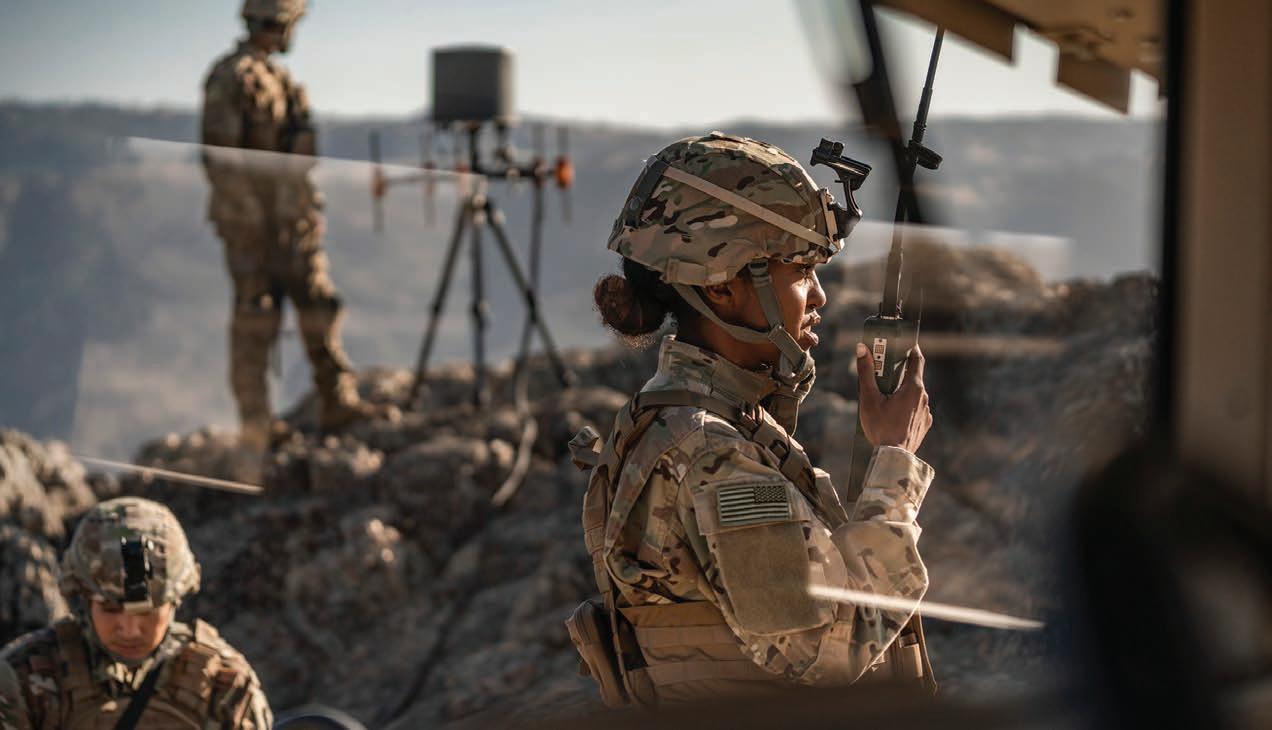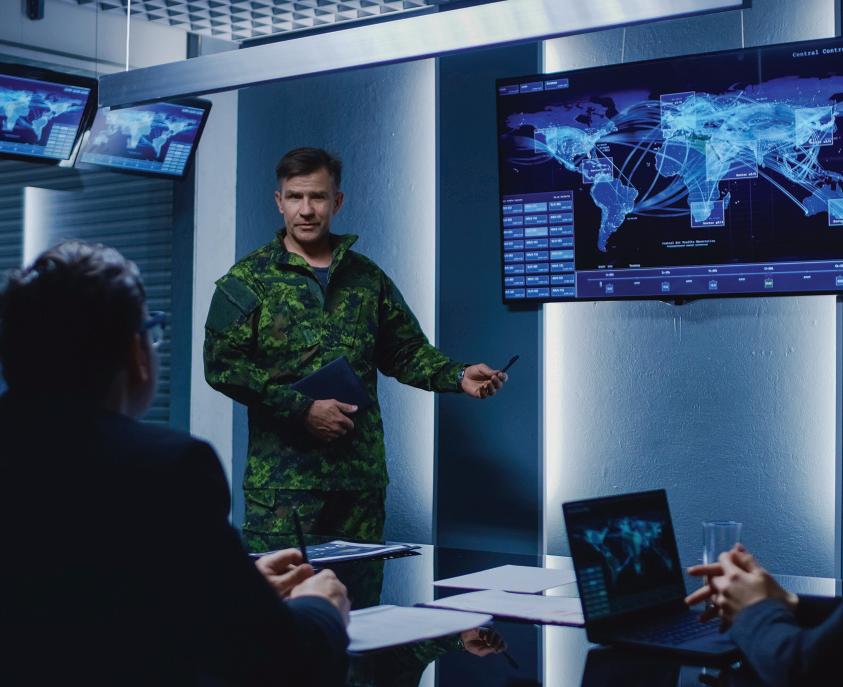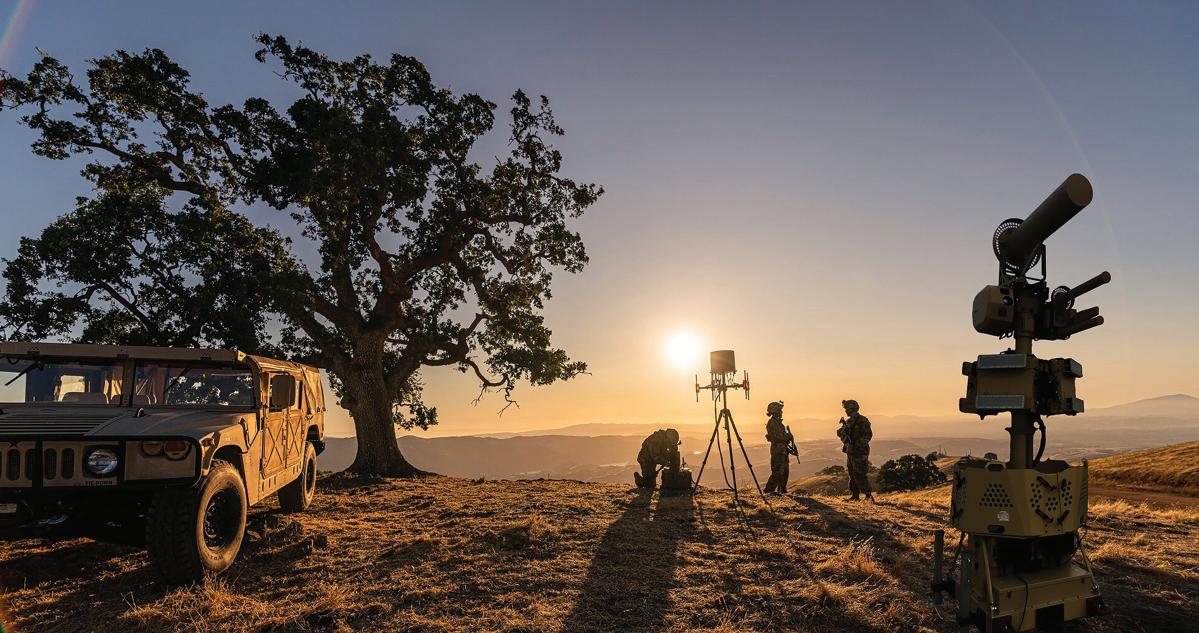
8 minute read
Countering UAS threats and strengthening critical communications in the modern battlefield
Communication and information are core to today’s defence teams. As Unmanned Aircraft Systems (UAS) develop, they are enabling agile information sourcing, fueling this advantage. At the same time, increased development and has led to a proliferation of their weaponization causing all sorts of unauthorised disruptions. Applications and experiences are still underway. Alongside, there will undoubtedly be a set of new unintended consequences.
Misho Tkalcevic, CTO and David Beckett, Business Development Director, TCI (part of SPX CommTech)
We are already seeing an increase in the development of modern Communications Intelligence (COMINT) to keep up with the proliferation of UAS on both sides of the conflict. The physical threat has become three-dimensional and now demands persistent land-based teams to spend as much time looking at unmanned activity on the ground, as well as on the water, and in the sky.
The advent of 5G networks and 5G-enabled UAS means the utility of commercial systems will only continue to broaden. They’re designed to operate in congested and contested environments where there is high interference and high volumes of usage across frequencies. This will increase the pressure and feed into the cycle of addressing the current threat and countering it before it swiftly evolves into the next iteration.
As a result, there’s an unprecedented need for CounterUAS (CUAS) solutions to enable defence teams to “find, fix, and finish” malicious devices in a strategic and cost-effective way.
One answer is Radio Frequency (RF) technology. RF presents the optimum platform to tackle UAS threats and adapt to what comes next. But why is this the case? How has it been deployed to date, and how will it continue to support military teams in the future?
Data analysis for effective Counter-UAS RF defeat
The ongoing news of malicious drone deployments and open access to UAS offensive plans over the internet has increased the urgency for effective defeat systems. Solutions that cause minimal collateral damage make it possible to preserve components for post-defeat research and forensics. This is where RF advances are not only proving to be crucial in combating UAS, but also in understanding command and control in the evolving UAS landscape.
The value of RF solutions also lies in their extensive possibilities for rapid technical exploitation of the target. RF detection can be extremely useful in characterising and rapidly identifying signals of hostile UAS. Recording the RF profile of hostile UAS allows military teams to build a ‘threat library’ of data that can help automate future searches and identification of unidentified systems. This analysis is crucial in determining the different levels of threat a specific UAS poses, and the response options to counter it.
As UAS have become more complex, their method of operation has become more diverse. In order to effectively defeat UAS, Counter-UAS systems should also include complementary detection sensors beyond RF. These include acoustic sensors, which identify the noise or sound of propulsion systems, or electro-optical systems that monitor movement within an environment. Together they form a comprehensive Counter-UAS system that doesn’t solely rely on RF detection.
Access to real-time granular information is helping drive network-centric warfare to become data-centric, which is fuelling the need for critical COMINT across the battlefield. Teams with the most precise information from multiple sources will likely win and, to do so successfully, the information exchange must be instantaneous so that the best tactical and deployment decisions can be made.

Battlespace team.
Photo courtesy iStock
Meeting unexpected consequences and challenges
As experiences on the battlefield continue to evolve, unintended consequences and the dynamic challenges of UAS are being uncovered.
For instance, in modern peer-on-peer conflicts, operating in the RF space and emitting a signal to counter a UAS poses a real risk of revealing a team’s location, meaning it is likely to become a target itself and put lives at risk. Furthermore, most of today’s UAS rely on navigation systems like GPS, which can also be subject to disruption and expose navigation vulnerabilities. This in turn pushes the need for high levels of encryption that protect sensitive data.
While RF radars are specialised at identifying movement, it’s often been a challenge to correctly identify an approaching threat – leading to a constant need to re-calibrate the systems to help capture drones that are travelling at increased or decreased speeds. While we continue to learn and adapt, technology has progressed to balance active RF radar and passive RF sensors for accurate UAS detection, identification, location, and tracking.
Another key challenge lies in how defence organisations appropriately prioritize and respond to a threat. Low-cost commercial UAS often are deployed in volume, whilst high-tech and high-cost UAS are used more selectively. Both can have a significant impact on the battlefield and the decision to use costly hard-kill solutions can create a dilemma. With a range of scenarios in an increasingly complex environment, defence users are working hard to develop concepts of operations (CONOPS) and implement a multi-layered approach of weapons systems against equally multi-layered target sets.

Military teams using the SPX CommTech BLACKTALON Counter-UAS solution, developed by TCI and ECS.
Photo courtesy SPX CommTech
In this context, despite its high initial expense, conducting an early investment in soft-kill solutions means these can be redeployed over time to help accurately identify the threat and determine the right level of response. The high rate of re-use and precision makes RF a key ally for teams on the ground. The surge in commercial UAS is leading to a greater influence on the future procurement of battlefield communications and applications to manage future tactical situations.
New technological trends driving COMINT
Modern battlefield communications are becoming data-centric with new technologies and capabilities to support the development and execution of multi-domain operations –allowing the modern military to be more flexible in adapting and responding to threats across all domains in a coordinated manner. Command, Control, Communications, Computers, Intelligence, Surveillance and Reconnaissance (C4ISR) is at the core of this, and COMINT and UAS detection and defeat have an important role to play in the defence of that capability.
Artificial Intelligence (AI) will become omnipresent in all military capabilities whether it be in communications, intelligence, surveillance, target acquisition and reconnaissance (ISTAR), COMINT, or in weapon systems. Going forward we expect it will be much easier to approve the use of AI in a softkill Counter-UAS than it would be to include AI and remove the human element from a hard kill weapon system.
Additionally, satellite communications will continue to be more accessible through standards such as MUOS (Multiple User Objective System), a beyond-line-of-sight system that is much harder to detect, and much more resistant to interference. Most importantly, this system will have much higher capacity and availability to users on the ground than traditional satellite communications. We’re also seeing mesh radios increase the robustness of information delivery as they’re less prone to interruption in communications.
We also expect to see a move away from the heavy reliance upon satellite navigation systems which provide position, navigation, and timing information. Should the satellites not be available to provide position, navigation, and timing platformbased solutions such as inertial navigation, atomic clocks and oscillators will become increasingly more available and crucial on the battlefield.

Military teams using the SPX CommTech BLACKTALON Counter-UAS solution, developed by TCI and ECS.
Photo courtesy SPX CommTech
Finally, although not a direct capability on the ground, we anticipate an increase in the ability of governments to adjust acquisition models to rapidly procure equipment at the speed of relevance. Any delay in the acquisition and deployment of a solution could render the system out of date when it reaches military teams on the battlefield. In this context, we are seeing NATO countries working towards avoiding vendor lock-in. This ultimately places users in the driving seat for the rapid optimization of their capabilities through modifications over the air – for instance, reprogramming systems to include new waveforms and crypto.
Information will always be the key to effective Counter-UAS
Whether it’s for commercial or military purposes, the timely flow and delivery of information is crucial. Whilst most technological adaptations come from present-day necessity, we are seeing a longer-term thinking of data distribution on network-centric communications. This also applies to optical communications, which are very hard to intercept but also extremely complex to use.
As “threat libraries” grow, they will lead to more and more data for AI and machine learning (ML) purposes to quickly identify new threats. With the growth in three-dimensional detection across air, sea, and land combined with 3D radars using RF technology, we can expect to see teams starting to merge information from various sensors to make more informed decisions – either fully automatically or semi-automatically.
Ultimately, striking a balance between accessibility and the right solution to use will determine whether there will be more disruptive technology on the horizon that reaches the battlefield and changes the landscape of UAS and Counter-UAS solutions. In the long term, we anticipate continued cross-pollination between commercial communications and military communications, which will continue to drive easy access to technology from a perspective of availability and use.
Like many companies, at SPX CommTech we’re constantly looking at the market dynamics to understand where we invest in R&D and want to enable more software-defined functionality and performance which will allow teams to optimize their capability for a specific use when it is needed, as well as the flexibility and agility to rapidly re-roll or optimize equipment for other missions.
The aim is to be one step ahead of the world’s next challenge and continue to inch closer to a smarter and more secure future for all.





